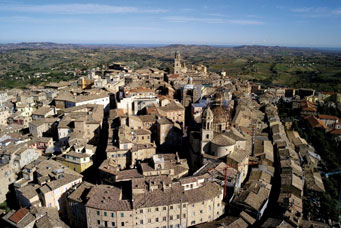The old town

- The view of the old town of Macerata
The Town’s coat of arms shows a quartered red shield and a golden royal crown of ancient type which appears over the shield, which in turns is divided in four quarters with two millstones and two Greek cross.
The Town of Macerata was founded in 1138 uniting two hill settlements, called Podium Sancti Juliani and Castrum Maceratae, it prospered during the following centuries and expanded the built up area building the strong city walls whose construction was finished at the end of the sixteenth century by Cristoforo Resse,
an architect who was already working for the Holy House of Loreto (Santa Casa di Loreto).
In the uncertain etymology of its name, Macerata denotes the ancient connection to the Roman Helvia Ricina, on whose ruins (“macerie” )it has been erected or, according to other sources, recalls the wide spread use to ret (“macerare”) flax and hemp.
The town has been the seat of diocese since 1320 and of a Faculty of Law which dates back to 1290.
After alternating the rule of many lords, the town became the seat of “Rettore della Marca” (Lord Protector) in 1445 and increased its own predominance.
Towards the first half of ‘500 it was a flourishing Renaissance town to which Pope Paul III conceded the University.
Macerata is the birthplace of the great Matteo Ricci, the Jesuit missionary who travelled into China in 1582 and who is acknowledged nowadays as the ingenious artefix of the first modern meeting between the western culture and the Chinese civilisation thanks to his evangelisation and to the depth and richness of his philosophical and scientifical works.
Nowadays the historical centre preserves only some tracts of the town at the time of Ricci.
The narrow concentrical rows, that cut the hill at different levels and moreover the most important streets converge in piazza della Libertà.
All these show signs of the more recent history which underwent a substantial urban intervention at the beginning of the XVII century and a series of important buildings half way through the following century.
The early XVIII century is then characterized in an indelible way by the most evident monumental episode of the whole historical centre, the “Sferisterio”, the arena created for the “palla al bracciale” game (ball and bracelet), which had been designed by Ireneo Aleandri and was inaugurated in 1829.
Sede Fiscale: Viale Trieste 24
Tel. (0733) 2561 - Fax (0733) 256200
Codice Fiscale 80001650433
